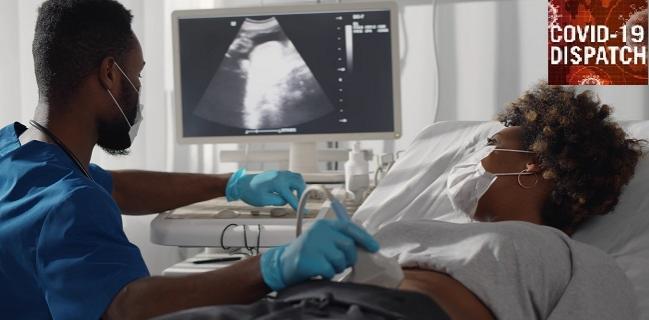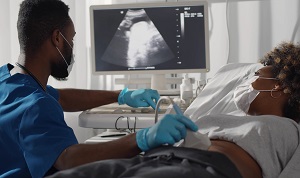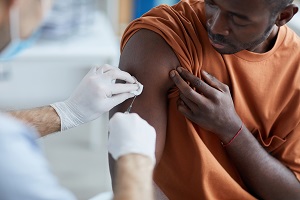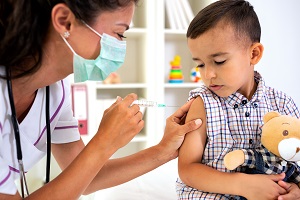COVID-19: TCTMD’s Daily Dispatch for March Week 3
We’re curating a list of COVID-19 research and other useful content, and updating it daily.

TCTMD reporter Todd Neale is keeping up on breaking news and peer-reviewed research related to COVID-19 and will update daily. If you have something to share, tell us. All of our COVID-19 coverage can be found on our COVID-19 Hub.
March 19, 2021
In the New York Times, Allison McCann and Lazaro Gamio look at who can get a vaccine and who can’t in countries around the world. “Getting a vaccine,” they write, “means living in the right place—or knowing the right people.”
 European policy makers are pushing to get vaccinations back on track after regulators in the EU and the UK declared that the AstraZeneca shot will benefit far more people than it potentially harms. At least 13 European countries had paused their use of the vaccine amid concerns about side effects, but many revised their position today. Germany and Italy are among those restarting vaccinations, while France recommended that the shot only be used in those older than 55, out of fears that younger patients were more likely to develop the brain clots, Reuters reports.
European policy makers are pushing to get vaccinations back on track after regulators in the EU and the UK declared that the AstraZeneca shot will benefit far more people than it potentially harms. At least 13 European countries had paused their use of the vaccine amid concerns about side effects, but many revised their position today. Germany and Italy are among those restarting vaccinations, while France recommended that the shot only be used in those older than 55, out of fears that younger patients were more likely to develop the brain clots, Reuters reports.
But for everyone hoping that vaccines will result in a swift return to “normal,” a mathematical modelling study published in the Lancet Infectious Diseases hammers home the point that vaccination alone will be insufficient to stamp out COVID-19. “Removal of all [nonpharmaceutical interventions] once the vaccination program is complete is predicted to lead to 21,400 deaths (95% CI 1,400-55,100) due to COVID-19 for a vaccine that prevents 85% of infections, although this number increases to 96,700 deaths (51,800-173,200) if the vaccine only prevents 60% of infections,” researchers write. The numbers reflect the UK population over a 3-year period starting January 1, 2021.
A national survey of healthcare workers conducted by the KFF and the Washington Post found that just over half of US frontline health workers had received at least one vaccine dose by early March. Three out of 10 say they haven’t decided whether or not to get the vaccine, while almost one in five (18%) say they don’t plan on getting vaccinated. Potential side effects and the vaccines’ “newness” are among the cited reasons. Health workers without a college degree, those who identify as Republican or Republican-leaning, and African Americans are among those who say they don’t want the jabs.
The US Centers for Disease Control and Prevention updated its guidance today to state that 3 feet of separation, rather than 6, is sufficient for elementary school children. Also, they advise that ventilation plays a key role in keeping kids safe.
 Schools that put in place strict mitigation strategies such as mandatory masks, increased ventilation, and physical distancing have lower transmission rates than the community, according to an analysis of 22 schools, kindergarten to grade 12, published today in Morbidity and Mortality Weekly Report. Two other school-based analyses also released Friday—one from Florida and the other from Utah, help flesh out the evolving story. Together they make the case that while in-person instruction carries risks, COVID-19 transmission can be minimized through mask adherence and physical separation strategies.
Schools that put in place strict mitigation strategies such as mandatory masks, increased ventilation, and physical distancing have lower transmission rates than the community, according to an analysis of 22 schools, kindergarten to grade 12, published today in Morbidity and Mortality Weekly Report. Two other school-based analyses also released Friday—one from Florida and the other from Utah, help flesh out the evolving story. Together they make the case that while in-person instruction carries risks, COVID-19 transmission can be minimized through mask adherence and physical separation strategies.
An opinion piece in the BMJ makes the case for incentivizing vaccinations in the United States as components of state-wide reopening plans. One strategy would be to have specific guidelines restricting unvaccinated individuals, such as predeparture and postarrival quarantines for travel, or limits on business capacity. Another would be to use community vaccine levels to guide the extent of restriction removal. “In the coming days and weeks US policymakers and public health leaders can capitalize on this pivotal moment to ensure that vaccine hesitancy does not stand in the way of this hard-earned and long-awaited goal,” the authors state.
US vaccine strategists need to work with the nation’s dialysis providers to ensure that Americans with kidney failure, “one of the nation’s most at-risk groups,” get vaccinated promptly. The solution for the half a million US subjects with kidney failure would be to have them get vaccinated when they come in to clinics for dialysis, an article in STAT proposes.
SARS-CoV-2 may have been circulating in China’s Hubei province as early as mid-October, but the original variant was likely less “fit” than the strain ultimately associated with the first-described cluster at the Huanan Seafood Wholesale Market in late-December 2019, researchers hypothesize in Science. Modelling studies raise the possibility that an earlier strain went extinct after giving rise to a mutant that persisted and was ultimately detected in Wuhan, setting off the current pandemic.
A cross-sectional study in Wuhan, China, of more than 9,500 individuals from nearly 3,600 families suggests that 6.92% of the population developed antibodies against SARS-CoV-2 and, within that group, 80% had been asymptomatic during the first wave of the pandemic. Of those who initially developed antibodies, 39.8% seroconverted to have neutralizing antibodies that were stable for at least 9 months, and seroconversion was not linked to being symptomatic or asymptomatic. “Our durability data on humoral responses indicate that mass vaccination is needed to effect herd protection to prevent the resurgence of the epidemic,” investigators conclude in the Lancet.
Among more than 9 million adults aged 65 and under during the first wave of the pandemic in the UK, living with children was not associated with an increased risk of SARS-CoV-2 infection, investigators write in the BMJ. In the second wave, living with children did appear to be associated with an increased risk of testing positive or being admitted to hospital; however, there was no difference in the risk of COVID-19 mortality associated with living with children between phase 1 and phase 2, and absolute increases in risk were small.
 A systematic review of 42 studies involving 438,548 pregnant women, published in the Canadian Medical Association Journal, concludes that SARS-CoV-2 in pregnancy is associated with preeclampsia, stillbirth, preterm birth and other adverse outcomes. “Our findings suggest that pregnant people with COVID-19 have an increased risk of high blood pressure, stillbirth and preterm birth, [and] their newborns are more likely to need intensive care. Pregnant people with severe COVID-19 symptoms have a particularly high risk of these complications,” study co-author, Nathalie Auger, MD, is quoted in a press release.
A systematic review of 42 studies involving 438,548 pregnant women, published in the Canadian Medical Association Journal, concludes that SARS-CoV-2 in pregnancy is associated with preeclampsia, stillbirth, preterm birth and other adverse outcomes. “Our findings suggest that pregnant people with COVID-19 have an increased risk of high blood pressure, stillbirth and preterm birth, [and] their newborns are more likely to need intensive care. Pregnant people with severe COVID-19 symptoms have a particularly high risk of these complications,” study co-author, Nathalie Auger, MD, is quoted in a press release.
TCTMD managing editor Shelley Wood contributed today’s Dispatch.
March 18, 2021
After concluding its preliminary review of recent reports of blood clots and low platelet counts, the European Medicines Agency (EMA) is reiterating its position that the benefits of the AstraZeneca/Oxford vaccine outweigh any risks, pointing out that COVID-19 itself triggers thromboembolic events. These adverse events reported “are rare cases,” the EMA stated today. “Around 20 million people in the UK and [European Economic Area] had received the vaccine as of March 16 and EMA has reviewed only seven cases of blood clots in multiple blood vessels (disseminated intravascular coagulation) and 18 cases of cerebral venous sinus thrombosis. A causal link with the vaccine is not proven, but is possible and deserves further analysis.”
The announcement comes as more than a dozen countries, most in Europe, have pressed pause on vaccinations with this particular vaccine, even as infections and serious cases spike anew. The New York Times details the juggling act that’s pitting vaccine fears against a lethal third wave.
 Another study—the second this week—is reporting that case fatalities are higher with the B.1.1.7 variant first identified in the United Kingdom. Daniel J. Grint, PhD, and colleagues writing in Eurosurveillance report that the strain was associated with a two-thirds higher case fatality than the previously circulating virus among an unvaccinated population in Britain. “For every three deaths in a population with the previously circulating virus we would expect five deaths in a similar population with VOC,” they write. “Crucially, emerging data suggest that the currently approved vaccines for SARS-CoV-2 are effective against the B.1.1.7 variant of concern.”
Another study—the second this week—is reporting that case fatalities are higher with the B.1.1.7 variant first identified in the United Kingdom. Daniel J. Grint, PhD, and colleagues writing in Eurosurveillance report that the strain was associated with a two-thirds higher case fatality than the previously circulating virus among an unvaccinated population in Britain. “For every three deaths in a population with the previously circulating virus we would expect five deaths in a similar population with VOC,” they write. “Crucially, emerging data suggest that the currently approved vaccines for SARS-CoV-2 are effective against the B.1.1.7 variant of concern.”
Another study published today reports a 67% increased risk of death rate for B.1.1.7 (compared with ancestral strain), controlling for confoundershttps://t.co/1MvFIXG7dH pic.twitter.com/5aHJgzQC1v
— Eric Topol (@EricTopol) March 18, 2021
An “intermediate” dose of prophylactic anticoagulation was no different than a standard prophylactic dose in preventing a primary composite outcome of venous or arterial thrombosis, treatment with extracorporeal membrane oxygenation, or mortality within 30 days, the randomized INSPIRATION trial suggests. Results were published today in JAMA, with investigator’s concluding: “These results do not support the routine empirical use of intermediate-dose prophylactic anticoagulation in unselected patients admitted to the ICU with COVID-19.”
INSPIRATION joins a growing list of trials attempting to tease out the role of antithrombotics in managing COVID-19 patients or preventing severe disease and death. TCTMD’s L.A. McKeown looked into the key takeaways from a major review of the clinical trials to date, published earlier this week in the Journal of the American College of Cardiology.
 The American Heart Association (AHA) and the Society of Critical Care Medicine (SCCM) are announcing plans to collaborate on a research initiative “to better understand the virus impact on patient care and outcomes for conditions, including myocarditis and cardiomyopathy.” The joint effort is intended to boost patient numbers for analysis by combining deidentified data from the AHA’s COVID-19 CVD Registry and the SCCM’s Discovery Viral Infection and Respiratory Illness Universal Study (VIRUS) COVID-19 registry. The latter currently has 65,000 patients enrolled, a statement notes.
The American Heart Association (AHA) and the Society of Critical Care Medicine (SCCM) are announcing plans to collaborate on a research initiative “to better understand the virus impact on patient care and outcomes for conditions, including myocarditis and cardiomyopathy.” The joint effort is intended to boost patient numbers for analysis by combining deidentified data from the AHA’s COVID-19 CVD Registry and the SCCM’s Discovery Viral Infection and Respiratory Illness Universal Study (VIRUS) COVID-19 registry. The latter currently has 65,000 patients enrolled, a statement notes.
Repeat COVID-19 infections are rare, protecting most people against reinfection at least in the first 6 months, a large-scale Danish study suggests. People over 65 are at greater risk of catching COVID-19 a second time, with only 47% “protection” against subsequent disease, as compared with 80% protection in younger people. One caveat, note the authors who reported their findings yesterday in the Lancet, is that this study focused only on the original SARS-CoV-2 strain, not the emerging variants.
Confirming prior studies, a retrospective analysis of the Veteran’s Affairs Data Warehouse indicates that rates of venous thromboembolism (VTE) were significantly higher for 4,461 hospitalized patients with a positive COVID-19 diagnosis as compared to hospitalized patients testing negative, despite thromboprophylaxis. VTE risk persisted after hospital discharge, remaining significantly higher in the COVID-19-positive group out to 200 days. “The rate of VTE among hospitalized COVID-19 positive patients is high and persists postdischarge justifying ongoing studies for thromboprophylaxis among patients with COVID-19,” J. Antonio Gutierrez, MD, and colleagues conclude in the American Heart Journal.
 The US Centers for Disease Control and Prevention (CDC) has announced a plan to invest $2.25 billion over 2 years targeting COVID-19 health disparities, aiming for “health equity among populations that are at high-risk and underserved, including racial and ethnic minority groups and people living in rural areas.” A statement notes that the funding “represents CDC’s largest investment to date to support communities affected by COVID-19-related health disparities.”
The US Centers for Disease Control and Prevention (CDC) has announced a plan to invest $2.25 billion over 2 years targeting COVID-19 health disparities, aiming for “health equity among populations that are at high-risk and underserved, including racial and ethnic minority groups and people living in rural areas.” A statement notes that the funding “represents CDC’s largest investment to date to support communities affected by COVID-19-related health disparities.”
The US Food and Drug Administration (FDA)’s Center for Drug Evaluation and Research (CDER) has launched a new website where it will disclose information relating to the scientific review of drug and biological therapeutic products being considered under the Emergency Use Authorizations (EUA) pathway. Intended to promote public confidence in the EUA process, the website currently includes information on bamlanivimab (alone or in combination with etesevimab), baricitinib in combination with remdesivir, and REGEN-COV (combining casirivimab and imdevimab).
The FDA also announced that it has granted marketing authorization to a diagnostic test first cleared under the EUA process—the first to be approved using the de novo premarket approval process following an EUA. “The grant of this de novo request marks an important step in FDA’s response to the COVID-19 pandemic because it is the first SARS-CoV-2 diagnostic test that will be permitted to be marketed beyond the public health emergency,” the FDA announcement notes.
TCTMD managing editor Shelley Wood contributed today’s Dispatch.
March 17, 2021
 COVID-19 cases are on the rise in 10 US states, even as the vaccine rollout continues at a pace envied by countries elsewhere. The United States is under pressure to share some of the doses currently going unused, including its stockpile of AstraZeneca vaccines, which have not yet been cleared for use in the US. Mexico has formally requested a vaccine “loan,” Reuters reports.
COVID-19 cases are on the rise in 10 US states, even as the vaccine rollout continues at a pace envied by countries elsewhere. The United States is under pressure to share some of the doses currently going unused, including its stockpile of AstraZeneca vaccines, which have not yet been cleared for use in the US. Mexico has formally requested a vaccine “loan,” Reuters reports.
A two-dose regimen of the Oxford/AstraZeneca vaccine (ChAdOx1) failed to protect against mild-to-moderate COVID-19 caused by the B.1.351 variant, according to results of a multicenter double-blind trial conducted in South Africa, where this strain originated. “Deliberations on the utility of the ChAdOx1 nCoV-19 vaccine also need to be made in the context of ongoing global spread and community transmission of the B.1.351 variant and the evolution of other SARS-CoV-2 lineages that include similar mutations,” investigators conclude. Full results were published yesterday in the New England Journal of Medicine.
Rita Rubin, MA, writing in JAMA, reviews how well the vaccines developed so far protect against known variants and how that scenario will continue to shift over time. “Viruses copying themselves, it’s almost like a game of telephone,” Penn State biologist David Kennedy, PhD, is quoted. “They repeat what they thought they heard, so they make mistakes all the time.”
The European Union may halt vaccine shipments to the United Kingdom to “safeguard doses” for EU citizens unless the UK reciprocates by shipping vaccine to the European bloc, the Guardian reports. “It is hard to explain to our citizens why vaccines produced in the EU are going to other countries that are also producing vaccines, but hardly anything is coming back,” European Commission President Ursula von der Leyen said.
 The EU is also proposing a “Digital Green Certificate” to allow residents of member nations who’ve been vaccinated to be able to travel freely around bloc countries, hopefully giving a boost to economies in time for the summer tourist season. “The commission’s plan is yet another bid to coordinate what is now a chaotic patchwork of disparate national measures, significantly hindering travel within the previously borderless zone,” the New York Times reports.
The EU is also proposing a “Digital Green Certificate” to allow residents of member nations who’ve been vaccinated to be able to travel freely around bloc countries, hopefully giving a boost to economies in time for the summer tourist season. “The commission’s plan is yet another bid to coordinate what is now a chaotic patchwork of disparate national measures, significantly hindering travel within the previously borderless zone,” the New York Times reports.
“Living practice points” compiled by the Scientific Medical Policy Committee of the American College of Physicians address questions about antibody response and natural immunity to COVID-19 following SARS-CoV-2 infection. Key takeways: don’t use antibody tests for diagnosis but do use them to estimate community prevalence of infection. For now, the authors conclude, the “current evidence is uncertain to predict presence, level, or durability of natural immunity conferred by SARS-CoV-2 antibodies against reinfection.”
Italian authors writing in the Journal of Cardiovascular Computed Tomography who reviewed chest CT scans for 1,093 consecutive patients admitted to one of 16 Italian hospitals found that higher coronary artery and total thoracic calcium scores appears to predict COVID-19 mortality. “Coronary, aortic valve and thoracic aortic calcium assessment on admission non-gated CT [can be used] to stratify the COVID-19 patients in-hospital mortality risk,” they propose.
Racial and ethnic minority groups have been hardest hit in the COVID-19 pandemic, but in the first 2.5 months of the US vaccine rollout, it seems vaccinations did not reach those who need them most. A review of 49,264,338 vaccinations in 49 US states suggests that counties with the highest social vulnerability index, as measured by the Centers for Disease Control and Prevention (CDC), have had significantly lower vaccine coverage (13.9%) than counties with lower social vulnerability (15.8%). The paper is published today in Morbidity and Mortality Weekly Report.
 A French cohort study, published in JAMA, describes coronavirus disease sequelae at 4 months among patients who were hospitalized for COVID-19 between March and May 2020. Lung scan abnormalities on CT were seen in 63% of 171 patients scanned, and at least one new symptom (notably fatigue, dyspnea, or cognitive symptoms) was reported in half of 244 patients interviewed by phone.
A French cohort study, published in JAMA, describes coronavirus disease sequelae at 4 months among patients who were hospitalized for COVID-19 between March and May 2020. Lung scan abnormalities on CT were seen in 63% of 171 patients scanned, and at least one new symptom (notably fatigue, dyspnea, or cognitive symptoms) was reported in half of 244 patients interviewed by phone.
A powerful, animated infographic in the New York Times, developed in collaboration with engineers and building system experts, shows the importance of open windows, ventilation fans, and air cleaners for safely reopening schools. “This simulation was created using a three-dimensional model of a New York City public school classroom, with specific inputs for the size of the room and the number of occupants and their location in the room, among other factors,” an explainer reads. Nearly 800,000 points of data were sampled from a simulation of airflow in the room.”
TCTMD managing editor Shelley Wood contributed today’s Dispatch.
March 16, 2021
 More than a dozen countries have now suspended the use of the AstraZeneca vaccine, even as Australia, Britain, and Thailand move ahead with it, the New York Times reports. The European Medicines Agency announced today that its safety committee (PRAC) will meet March 18 to “further discuss” information gathered to date on the AstraZeneca vaccine and thromboembolic events. On a live press briefing, EMA head Emer Cooke said she remains “fully convinced” that the benefits of this vaccine outweigh the risks, but added that the thromboembolism cases “are a serious concern and need serious and detailed scientific evaluation,” as the Guardian reports.
More than a dozen countries have now suspended the use of the AstraZeneca vaccine, even as Australia, Britain, and Thailand move ahead with it, the New York Times reports. The European Medicines Agency announced today that its safety committee (PRAC) will meet March 18 to “further discuss” information gathered to date on the AstraZeneca vaccine and thromboembolic events. On a live press briefing, EMA head Emer Cooke said she remains “fully convinced” that the benefits of this vaccine outweigh the risks, but added that the thromboembolism cases “are a serious concern and need serious and detailed scientific evaluation,” as the Guardian reports.
US President Joe Biden and his advisors are planning a “television, radio, and digital advertising blitz” with the aim of boosting vaccine uptake, Lev Facher reports for STAT. “Specifically, the campaign will target three groups in which access, apathy, or outright skepticism may pose a barrier to vaccinations: young people, people of color, and conservatives, according to a Biden aide. Congress and the administration have set aside over $1.5 billion for the effort.”
It’s a great day to be a Mississippian!
— Tate Reeves (@tatereeves) March 16, 2021
If you want a shot, you can get a shot! New appointments available statewide at https://t.co/AxGnAgTUeZ!
Great day indeed!
Mississippi has joined Alaska in being the first US states to announce that vaccines are now available to all, CNN reports.
A review of the US Centers for Disease Control and Prevention (CDC) concludes that the agency “failed to live up to its once-golden standards by issuing some guidance that wasn't primarily authored by its staff, didn't rely on the best scientific evidence and used watered-down language as the nation confronted the coronavirus pandemic,” which “hints at Trump administration meddling,” the USA Today reports. The review requested by the new CDC director, Rochelle Walensky, MD, was carried out by her principal deputy, Anne Schuchat, MD; its findings have been posted online.
 A commentary in Circulation today reviews the knowns and unknowns returning to sports following COVID-19 infection. “We propose that cardiologists engage in shared decision-making (SDM) with their asymptomatic patient athletes with ambiguous test results, to allow them the choice to participate in their sport as safely as possible,” write Benjamin H. Hammond, MD; Peter F. Aziz, MD; and Dermot Phelan, MD, PhD. “We advocate for attempting to use SDM in younger athletes with their parents, based on assessment of mature processing. We acknowledge that this process will differ when considering restriction for a short period of time, such as 3 months, when compared to a lifetime restriction in athletes with certain conditions. We also acknowledge the uncertainty that accompanies such a decision.”
A commentary in Circulation today reviews the knowns and unknowns returning to sports following COVID-19 infection. “We propose that cardiologists engage in shared decision-making (SDM) with their asymptomatic patient athletes with ambiguous test results, to allow them the choice to participate in their sport as safely as possible,” write Benjamin H. Hammond, MD; Peter F. Aziz, MD; and Dermot Phelan, MD, PhD. “We advocate for attempting to use SDM in younger athletes with their parents, based on assessment of mature processing. We acknowledge that this process will differ when considering restriction for a short period of time, such as 3 months, when compared to a lifetime restriction in athletes with certain conditions. We also acknowledge the uncertainty that accompanies such a decision.”
A “growing body of evidence” suggests that neuropsychiatric sequalae are an important consequence of COVID-19 infection, investigators conclude in JAMA Network Open. Their analysis, published as a research letter, surveyed 3904 US adults who’d recovered from COVID-19 between June 2020 and January 2021 and found that more than 50% met the criteria for symptoms of major depressive disorder.
A “Practice Pointer” in the BMJ offers some tips for assessing the risks to healthcare workers during the COVID-19 pandemic, including advice for approaching a staff member to discuss his or her individual risk.
 Moderna has begun to enroll children between the ages of 6 months and 11 years in its KidCOVE trial, with news outlets reporting that the first kids received the vaccine today. The study is both an age-de-escalation and a dose escalation trial, Forbes notes, meaning that enrollment is starting with the older children and working backwards while also starting with a lower dose of the vaccine and working up as the lower doses are proven to be safe.
Moderna has begun to enroll children between the ages of 6 months and 11 years in its KidCOVE trial, with news outlets reporting that the first kids received the vaccine today. The study is both an age-de-escalation and a dose escalation trial, Forbes notes, meaning that enrollment is starting with the older children and working backwards while also starting with a lower dose of the vaccine and working up as the lower doses are proven to be safe.
TCTMD managing editor Shelley Wood contributed today’s Dispatch.
March 15, 2021
 Italy once again imposed a strict country-wide lockdown today in an effort to stem the tide of a third wave of infections driven by more-infectious variants and a slow vaccine rollout. Cases are also spiking across Europe, with German doctors also calling for an “immediate lockdown” to prevent another wave there.
Italy once again imposed a strict country-wide lockdown today in an effort to stem the tide of a third wave of infections driven by more-infectious variants and a slow vaccine rollout. Cases are also spiking across Europe, with German doctors also calling for an “immediate lockdown” to prevent another wave there.
Researchers writing in Nature today report that the UK coronavirus variant known as B.1.1.7 is associated with 55% higher COVID-19 mortality than other lineages, rising to 61% after correction for misclassifications and “missingness,” authors say. That’s an even higher proportion than researchers first estimated back in January, which then led to a warning by British Prime Minister Boris Johnson. The updated numbers published today are based on an analysis of 4,900 deaths occurring within 28 days of a positive test, 3,100 of which were found to involve the B.1.1.7 variant.
CBS News’ 60 Minutes offers an in-depth look at the most worrisome coronavirus variants and why new strains keep “popping up.” A transcript of the show is posted on the website.
Italy, Norway, Iceland, Germany, Indonesia, and the Netherlands are among the latest countries to pause their rollout of the AstraZeneca vaccine. Reuters reports that Norway took the decision after three health workers there developed bleeding or clotting abnormalities. The New York Times points out that even as some countries halt vaccinations with this agent, others are pressing on: in Thailand, Prime Minister Prayuth Chan-ocha will be among the first to receive it, Tuesday.
A retrospective analysis of two Connecticut area nursing homes and 463 elderly residents suggests that “partial vaccination” with the Pfizer-BioNTech vaccine (representing the period more than 14 days after the first dose up to 7 days after the second) is associated with a 63% effectiveness against SARS-CoV-2 infection. Efficacy was “somewhat lower” during specific time windows in people aged 70 or older and in patients with three or more medical conditions. “Complete two-dose vaccination is an important strategy for preventing COVID-19 in this disproportionately affected population,” authors write in Morbidity and Mortality Weekly Report.

Skin rashes have increasingly emerged as a signature feature of COVID-19: now researchers combing through photos uploaded by 336,847 users to the COVID Symptoms Study app confirm that cutaneous symptoms were the first presentation of SARS-CoV-2 in 17% of subjects and skin rashes were the only clinical sign of COVID-19 in 21%. The authors, partnering with the British Association of Dermatologists, have put together an online image catalogue with the most common skin manifestations of the disease. Their paper is published in the British Journal of Dermatology.
Investigators writing in the American Journal of Neuroradiology say they’ve detected a “visual correlation” between the extent of COVID-19 disease on lung CT and the severity of brain effects seen on MRI. “We're finding, through patient experiences, that neurological symptoms are correlating to those with more-severe respiratory disease; however, little information has been available on identifying potential associations between imaging abnormalities in the brain and lungs in COVID-19 patients,” study author Abdelkader Mahammedi, MD, is quoted in a press release. "Imaging serves as proof for physicians, confirming how an illness is forming and with what severity, and helps in making final decisions about a patient's care."
 A study of 251 school districts comparing COVID-19 outbreaks at schools with social distancing policies of 3 feet or greater and those specifying separations of 6 feet or more has found similar case rates, a finding that held up for both students and staff. That has important implications for schools trying to reimagine safe configurations for kids, teachers, and other workers. “Lower physical distancing policies can be adopted in school settings with masking mandates without negatively impacting student or staff safety,” authors conclude in Clinical Infectious Diseases.
A study of 251 school districts comparing COVID-19 outbreaks at schools with social distancing policies of 3 feet or greater and those specifying separations of 6 feet or more has found similar case rates, a finding that held up for both students and staff. That has important implications for schools trying to reimagine safe configurations for kids, teachers, and other workers. “Lower physical distancing policies can be adopted in school settings with masking mandates without negatively impacting student or staff safety,” authors conclude in Clinical Infectious Diseases.
The US Food and Drug Administration has sent a Letter to Clinical Laboratory Staff, Point-of-Care Facility Staff and Health Care Providers warning that false positive results can occur with the cobas SARS-CoV-2 & Influenza A/B Nucleic Acid Test (Roche Molecular Systems) used on the cobas Liat System. The agency recommends monitoring for “unexpected clusters” of positive results, which might indicate a leak in the assay tubes that could lead to false positives, as well as retesting patients test positive for multiple analytes (influenza A, influenza B, and/or SARS-CoV-2) in a single test.
 To celebrate the occasion of his second coronavirus vaccine dose, internationally renowned cellist Yo-Yo Ma gave an impromptu performance at the Berkshire Community College vaccination center in Massachusetts during the observation period after his jab. He played for 15 minutes, wearing a mask; Berkshire College has posted clips to its Facebook page.
To celebrate the occasion of his second coronavirus vaccine dose, internationally renowned cellist Yo-Yo Ma gave an impromptu performance at the Berkshire Community College vaccination center in Massachusetts during the observation period after his jab. He played for 15 minutes, wearing a mask; Berkshire College has posted clips to its Facebook page.
TCTMD managing editor Shelley Wood contributed today’s Dispatch.
Shelley Wood was the Editor-in-Chief of TCTMD and the Editorial Director at the Cardiovascular Research Foundation (CRF) from October 2015…
Read Full Bio

Comments